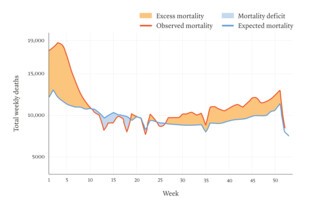One of the tactics used over the past few weeks by Boris Johnson at Prime Minister’s Questions, and by loyal MPs and dutiful ministers touring broadcasting studios, has been to claim that his successful management of the pandemic is more worthy of the public’s attention than trivial issues of garden parties or after-work drinks. We should forgive these misdemeanours, we’re told, because he ‘got all the big calls right’, as Johnson himself boasted to Keir Starmer at PMQs on 26 January. No one is minded to argue with him about this supposed success, wanting to return instead to the question of what he knew about the parties and whether he misled Parliament. The result is that we’ve heard the unchallenged assertion that Johnson made all the right decisions about the management of the pandemic so often that we’re starting to believe it. It’s reminiscent of the lie spread so successfully by the Tories after the 2008 financial crash, that the parlous state of public finances was the result of New Labour’s profligacy rather than the urgent need to bail out the banks.
Johnson did do some things right. The appointment of Kate Bingham, a formidable pharmaceutical industry insider, to lead the vaccine taskforce ensured early procurement. The roll-out was exactly the kind of thing the NHS is good at: it has the capacity to carry out large-scale actions, not least because it retains a substantially centralised control structure, and it attracts enough goodwill that volunteers are happy to help. When Omicron began to spread, many public health experts argued that, given the possibility of calamity, it would be prudent to shut down again. The government introduced some modest restrictions, the devolved administrations went a little further, but Johnson resisted calls for a stronger response. Case numbers rose sharply, hospital admissions and deaths rose less dramatically. The system was never overwhelmed and many will feel Johnson made the right call.
But to judge how well Johnson and his government have done overall, we need to look at how the UK compares to other countries. The most frequently reported figures used to track the progress of the pandemic – cases, hospitalisations, deaths – aren’t a good basis for international comparison. The number of cases is, in part, a reflection of the amount of testing, and the ways in which hospitalisations are recorded and deaths attributed to Covid (as distinct from some other cause) will also vary from country to country. The most robust measure is excess mortality, which compares the number of people known to have died since the pandemic began with an estimate of the number expected to die, based on the average number of deaths in, say, the previous five years.
Academic institutions and media outlets have been trying to collate data on this since the start of the pandemic. It isn’t always easy to get the figures: India and China are conspicuous absences from most comparisons, with the result that 35 per cent of the world’s population are excluded from estimates of the real global burden of the disease. Even when the data is available, it isn’t always amenable to straightforward interpretation. In Germany, for example, the number of people aged eighty or over increased by 20 per cent from 2016 to 2020 as the demographic deficit caused by the Second World War disappeared. The mortality rate, inevitably, also went up, in line with the increase in the number of people entering their ninth decade. This means that although deaths in Germany were 5 per cent higher in 2020 than in 2019, the pandemic may be responsible for only a fifth of that increase.
In June 2021 Ariel Karlinsky and Dmitry Kobak published a paper in which they used mortality data from various countries to calculate the excess mortality in each since the start of the pandemic, adjusting for expected mortality based on historical trends. They have continued to update these estimates. At the time of writing, the UK is ranked 40th out of 75 countries for which up-to-date data is available. Most of the worst-performing countries are in Eastern Europe or Central and South America (issues with data mean that there are almost no African countries on the list). Bulgaria is at the bottom with an excess mortality estimated at 860 deaths per 100,000 of population. The United States and Italy are the worst performers among countries that might be seen as comparable to the UK, coming in at 293 and 266 deaths per 100,000 respectively. Spain (230) and Portugal (216) also exceed the UK figure of 210 per 100,000, while France scores 119, Germany 113, Denmark 34. Japan is considered to have zero excess deaths, and in a few countries, including New Zealand, the score is negative, suggesting that measures taken to counter the pandemic saved more lives than were lost to the disease (social distancing meant that 2021 was a mild year for flu).
Many of the factors that affect the outcomes of the pandemic are nothing to do with the policy choices made by leaders. As John Lanchester wrote in the LRB (16 December 2021), the UK population is older and more obese than that in many other countries, and we live in crowded cities and have an unequal society, all of which makes us, collectively, more susceptible to Covid-19. On the other hand, the UK was, in many ways, in a good position to respond to the pandemic. It has an incredibly strong science base. It has a unified health system with widespread public support. There is a strong sense of civic responsibility, and severe restrictions on behaviour can be imposed with a minimum of enforcement. And yet 175,000 people died.
In Spike: The Virus v. the People (Profile, £14.99) Jeremy Farrar, an infectious disease specialist and director of the Wellcome Trust, who advised the government at the start of the pandemic, gives an insider’s – or near insider’s – account of its response. There is a long list of things that went wrong early on. The government didn’t at first seem to take the threat seriously. Even after this changed, neither it nor its advisers saw lockdown as a viable strategy until after the disease had already begun to spread in the UK. When Sage, the committee of scientists convened to inform government policy, finally started to brief ministers that a lockdown was necessary, the government hesitated just when incisive action was needed. There followed chaos and scandal around the implementation of test and trace, the procurement of PPE and the transfer of patients from hospitals to care homes.
There was plenty of blame to go around in this early period, but responsibility for the failure to impose a lockdown in autumn 2020 lies squarely with the prime minister, and represents a failure of judgment so catastrophic it should be unimaginable that any political career could survive it. When Sage convened on 21 September 2020, cases were doubling every week. Farrar says that Dominic Cummings, Patrick Vallance and Chris Whitty – respectively Johnson’s senior adviser, the government’s chief scientific adviser and the chief medical officer for England – were all convinced that intervention was needed, but Johnson simply refused to act. The next day, Cummings tried to get him to understand the consequences of his inaction, making him act out a meeting as it might unfold six weeks in the future. ‘It’s no good, I’m not doing it,’ Johnson told him. ‘It’s politically impossible and lockdowns don’t work.’ Some measures were put in place on 14 October, dividing the country into tiers with different levels of restriction, but on the 22nd, when Sage met again, the epidemic was still growing exponentially. The government finally caved in and imposed a lockdown from 5 November until 2 December. It was too little, too late. Transmission continued to rise in December. Further restrictions were imposed on the 19th, through the addition of a fourth tier. A planned loosening of restrictions over Christmas had to be abandoned and a full national lockdown was finally and chaotically imposed on 5 January, the day after schools reopened.
The Human Mortality Database allows users to plot estimates of the weekly totals of excess deaths in England and Wales in 2021. The graph shown here displays excess deaths in orange, and gives some impression of the carnage that followed Johnson’s recklessness and indecision. The Department of Health and Social Care’s own estimate of excess deaths in the first eight weeks of 2021 is 32,733.
Send Letters To:
The Editor
London Review of Books,
28 Little Russell Street
London, WC1A 2HN
letters@lrb.co.uk
Please include name, address, and a telephone number.


